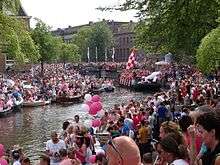Amsterdam Gay Pride


Amsterdam Pride or Amsterdam Gay Pride is a citywide gay-festival held annually at the center of Amsterdam during the first weekend of August. The festival attracts several hundred-thousand visitors each year and is one of the largest publicly held annual events in the Netherlands.
Amsterdam Pride was first organized in 1996, meant as a festival to celebrate freedom and diversity. It was therefore not like many other Gay Prides, which began as demonstrations for equal rights. The latter purpose served another event, which is called Pink Saturday (Dutch: Roze Zaterdag) since 1979 and is held in a different city each year since 1981.
The peak of the festival is during the Canal Parade, a parade of boats of large variety on the first Saturday of August, which usually goes from Westerdok over the Prinsengracht, the Amstel river, the Zwanenburgwal and the Oudeschans to Oosterdok. In 2014, the first Jewish boat and the first Moroccan boat participated in the Amsterdam Pride Canal Parade.[1][2][3]Dana International was on the Jewish boat, as well as the Fokkens twins (Louise Fokkens and Martine Fokkens), who are famous in the Netherlands for having worked 50 years as sex workers in Amsterdam’s Red Light District before their retirement earlier in 2014.[4] Marianne van Praag, a Reform rabbi from The Hague, was the only rabbi aboard the Jewish boat.[1]
The Amsterdam Gay Pride usually spans a week of various activities for lesbian, gay, bisexual and transgender (LGBT) people, including exhibitions, cultural and sport events. There are also street parties in the streets where there's a concentration of gay bars, like Reguliersdwarsstraat, Zeedijk, Warmoesstraat and alongside Amstel. On Rembrandtplein there's a closing party on the Sunday after the Canal Parade.[5]
Name change Amsterdam Pride
In 2015, the board of the Amsterdam Gay Pride took a different approach towards the name of the festival. The ProGay foundation, that founded the festival, argued that the term 'Gay' did not sufficiently express the diversity amongst the participants of the Pride. President of the board, Irene Hemelaar, confirmed that the change will be happening, but the name change only came through in 2017. By changing the name of the festival they hoped to encourage other prides to become more inclusive in their annual events. The Netherland Police Units participate in a yearly event that illustrate the inclusion of the Netherlands. The Netherlands' Police Department wear pink uniforms during the festival to emphasis the departments' support in the LGBT community.[6]
In 2016, the EuroPride had changed its community name to LGBTI, I for intersexual, since it was the first year in which there was an appearance of an intersexual community in the festivals' program. Since the Netherlands have learned about the intersexual community, digesting and learning their culture has been their top priority.The name change and the appearance of the 'I' in LGBTI worked to form a more inclusive environment for all people to celebrate their gender and sexuality.[7]
LGBT in Netherlands
Netherlands is one of the countries in showing high social acceptance to LGBT community in European countries. During the years, the social acceptance to LGBT groups has been increasing and Netherlands got top rankings in the several survey interpreting objective and open view towards LGBT comparing to other European countries such as Spain, United Kingdom and etc.. The neutral attitude of Dutch from different groups can be seen from the aspects of how the public view LGBT, acceptance on equal rights of LGBT, the visibility of the LGBT community and construction of networks of LGBT groups. For example, Netherlands has the highest ranking in supporting LGBT groups can have the freedom to pursue their desired lifestyles, feel least comfortable with LGBT political leaders. Moreover, for the attitudes of Dutch towards lesbians, gays and bisexuals are more open to that to transgendered people. This is also common in European societies which is caused by the transgendered groups are less common than the LGB groups and people are more likely to have more LGB friends or acquaintances. In the Netherlands, more than 75% of the interviewees revealed that they had LGB friends and they hold a positive stance towards homosexuality while less than 10% of the interviewees revealed that they had transgendered friends or acquaintances.
The general view of the Dutch Society towards LGBT is under an optimistic atmosphere and people support and open to promote the equalities and freedom of LGBT community.
References
- 1 2 "Archived copy". Archived from the original on 2015-02-17. Retrieved 2014-10-24.
- ↑ "Archived copy". Archived from the original on 2014-10-07. Retrieved 2014-10-24.
- ↑ http://www.moroccoworldnews.com/2014/08/136244/moroccan-lgbt-boat-sails-in-amsterdam-gay-pride-canal-parade/
- ↑ http://forward.com/articles/203478/flamboyant-first-as-jewish-boat-floats-in-amsterda/
- ↑ Program Amsterdam Pride 2007 Archived October 17, 2007, at the Wayback Machine.. Retrieved on 2007-10-13.
- ↑ "Amsterdam Gay Pride krijgt mogelijk andere naam | Metronieuws.nl". Metronieuws.nl (in Dutch). Retrieved 2018-02-09.
- ↑ "EuroPride 2016 festival magazine". Issuu. Retrieved 2018-02-09.
- ↑ Saskia Keuzenkamp Lisette, Kuyper. "Acceptance of lesbian, gay, bisexual and transgender individuals in the Netherlands in 2013".
External links
| Wikimedia Commons has media related to Amsterdam Gay Pride. |
- Amsterdam Gay Pride (official website)
- Amsterdam Gay Pride Canal Parade (Video)
- History of Amsterdam Gay Pride